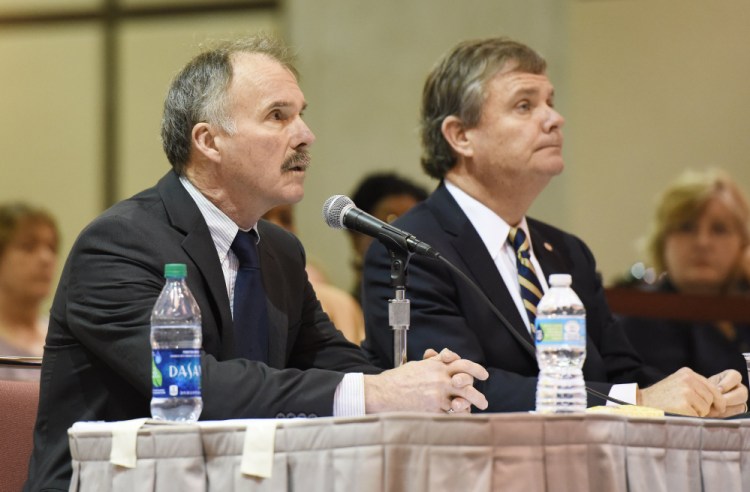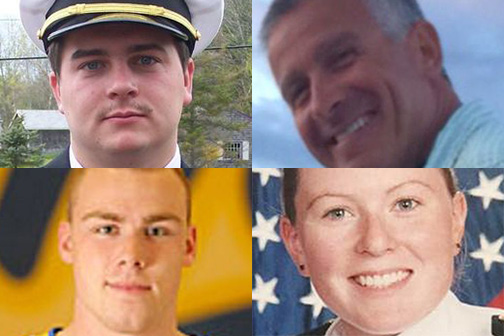A South Portland man who served as second mate on the El Faro but was on vacation when the cargo ship sank last October, killing all on board, tried to warn its captain of a tropical storm that forecasters predicted could turn into a hurricane.
Charles Baird told the Coast Guard Marine Board of Investigation during a hearing Thursday in Jacksonville, Florida, that he was watching the Weather Channel at his home when he learned that the storm could become a hurricane. Baird said that prompted him to send a text message to the captain, Michael Davidson of Windham, Maine, to make sure he was aware of the storm.
“He (Davidson) came back to me and said yes, and thank you,” Baird said. “When I saw it had developed into a Category 1 hurricane, I texted him again (to ask) what his plan was going to be.”
Baird told the board that Davidson responded by texting him back, saying he planned to follow his normal route but would skirt “under” – or south of – Hurricane Joaquin.
Baird told the Portland Press Herald by telephone Thursday that he lives in South Portland, but attempts to reach him Thursday night for additional comments regarding his testimony and experiences on board the El Faro were unsuccessful. Baird said he has sailed the route between Jacksonville and San Juan, Puerto Rico, for 12 years.
The 790-foot-long El Faro, which was headed from Jacksonville to San Juan, lost propulsion, began taking on water and sank Oct. 1 as it was enveloped by 130 mph winds and 30- to 40-foot waves churned up by Hurricane Joaquin, which had grown into a Category 4 storm.
Davidson had used a different approach during another strong storm just about a month earlier, Baird testified. Davidson had rerouted to a slower, safer route in August during Tropical Storm Erika after the ship’s owner, Tote Services Inc., sent out an alert.
Baird said it was his idea to sail the slower route through the Old Bahama Channel during Erika. A crew of Polish sailors was aboard the El Faro, working to prepare it for its upcoming move to the Alaska trade, he said, and the slower route was expected to be smoother so they could work.
A Polish crew was aboard the El Faro when it set sail during Joaquin, too, yet the more direct route closer to the storm was chosen.
No company alert was sent out for Hurricane Joaquin, and officials with the company that owned the El Faro, Tote Services Inc., have said they don’t routinely send out warnings.
El Faro sank off Crooked Island in the Bahamas in about 15,000 feet of water. The Navy eventually found the vessel on the ocean floor, about 2,000 feet deeper than the Titanic.
All 33 crew members were lost at sea.
SHIP’S WIND-SPEED GAUGE WAS BROKEN
In addition to Davidson, several other crew members with ties to Maine and Maine Maritime Academy drowned in the storm.
The victims also included Michael Holland, 25, of Wilton, and Danielle Randolph, 34, and Dylan Meklin, 23, both of Rockland. Davidson and the three crewmen, along with Mitchell Kuflik of Brooklyn, New York, were all graduates of Maine Maritime Academy in Castine.
Baird, the second mate, is also a Maine Maritime Academy graduate, according to WCSH-TV. He has since become third mate on El Faro’s sister ship, El Yunque.
While en route to Puerto Rico, Davidson emailed company officials the day before the El Faro sank, asking if he could take the slower route home, the board was told. A company official said yes.
Testimony on Thursday also revealed that the El Faro may have been sailing without the aid of a wind speed gauge called an anemometer. Baird said it had not been working for a couple of months before El Faro’s last voyage.
However, a broken wind speed gauge presented few difficulties for experienced mariners, Baird said.
“I can probably estimate it within 5 knots,” he said.
El Yunque’s captain, Earl Loftfield, was also called to testify before the Marine Board of Investigation on Thursday. He said an anemometer is simply a tool, but not something he would rely on to make a crucial sailing decision.
“It’s not important to me,” Loftfield testified. “It’s not a piece of required equipment.”
Not much could dissuade Tote’s captains from setting sail and getting their cargo delivered, Baird told the board. While arriving on time was important, Baird said there were no penalties for late delivery.
“Was there ever any instance where you did not sail from port because of adverse, bad weather,” asked Capt. Michael Kucharski, a National Transportation Safety Board marine accident investigator participating in the panel.
“No, we always sailed,” Baird said.
SECOND SEARCH MISSION PLANNED
The Coast Guard is trying to determine what factors led to the accident, whether there was evidence of misconduct, inattention to duty, or negligence. The Coast Guard will eventually issue a report of its findings to the maritime community.
The Coast Guard was unable to find any survivors or bodies after the El Faro sank. The ship’s voyage data recorder, which could have provided investigators with a better understanding of what happened, has not been located. But the NTSB announced this month that it will launch a second mission to find the VDR.
A search area encompassing 13.5 square miles will be documented in photos and videos by SENTRY, an autonomous underwater vehicle that will be launched from the Navy research vessel Atlantis. The Atlantis can operate at depths of 20,000 feet and can be equipped with a wide array of sonar, camera and other sensors.
El Faro’s VDR was capable of recording conversations and sounds on the navigation bridge, which could provide investigators with a better understanding of the sequence of events that led to the ship’s sinking. The NTSB has not announced when the second mission will take place.
The Coast Guard began the hearings Tuesday. They will continue daily – except Sundays – through Feb. 26. The hearings run from 9 a.m. to 5 p.m. at the Prime Osborn Convention Center in Jacksonville.
Portland Press Herald staff writers Dennis Hoey and Matt Byrne and The Associated Press contributed to this report.
Send questions/comments to the editors.




Success. Please wait for the page to reload. If the page does not reload within 5 seconds, please refresh the page.
Enter your email and password to access comments.
Hi, to comment on stories you must . This profile is in addition to your subscription and website login.
Already have a commenting profile? .
Invalid username/password.
Please check your email to confirm and complete your registration.
Only subscribers are eligible to post comments. Please subscribe or login first for digital access. Here’s why.
Use the form below to reset your password. When you've submitted your account email, we will send an email with a reset code.